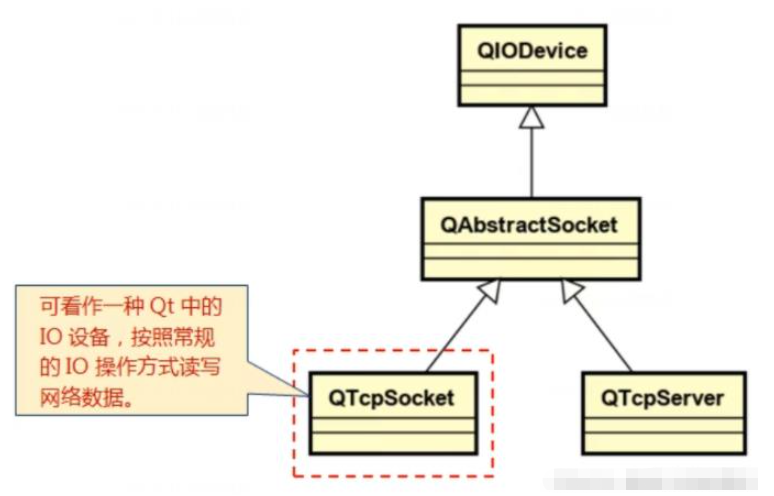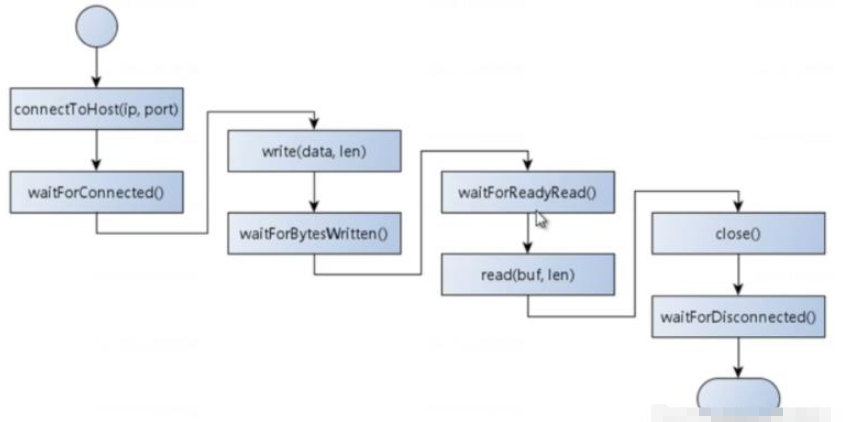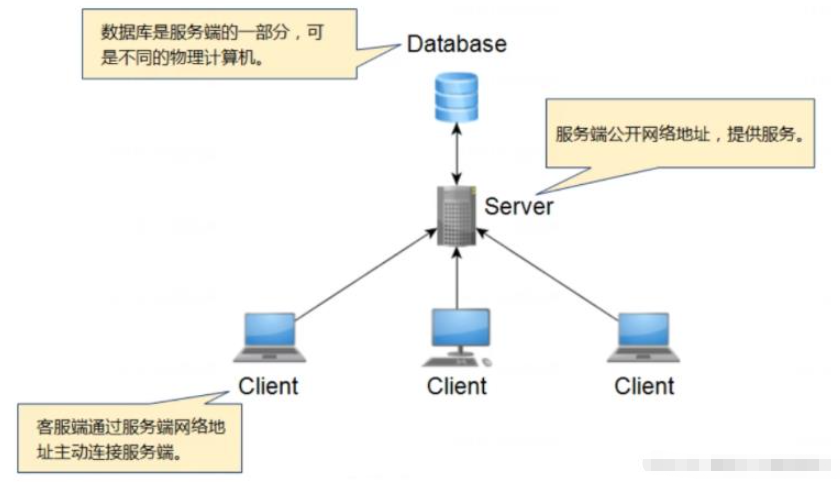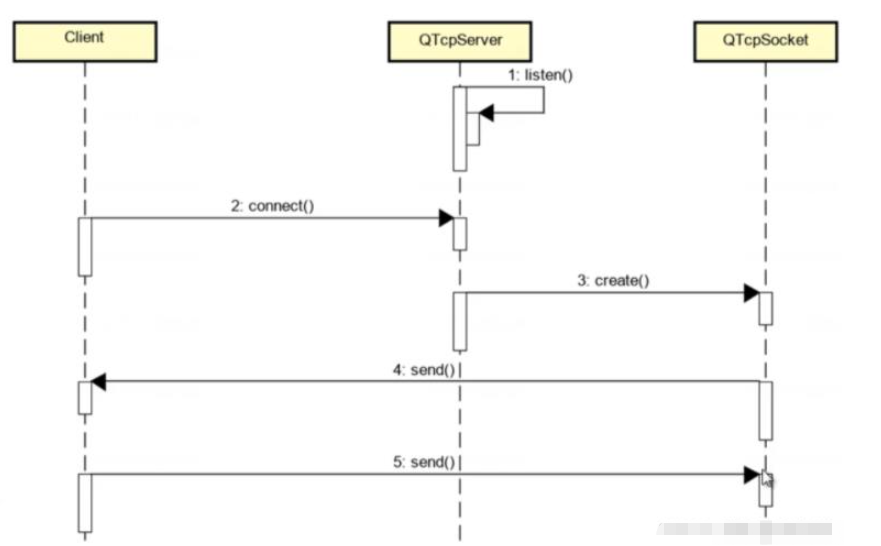本篇内容主要讲解“怎么用Qt实现TCP网络编程”,感兴趣的朋友不妨来看看。本文介绍的方法操作简单快捷,实用性强。下面就让小编来带大家学习“怎么用Qt实现TCP网络编程”吧!
1.Qt中的TCP客户端编程

Qt中的TCP客户端编程:
对于Qt编程而言,网络只是数据传输的通道
Qt提供了QTcpSocket类(封装了TCP协议细节)
将QTcpSocket的对象当做黑盒使用,进行数据收发

QTcpSocket的使用方式:
1.连接服务端主机(connectToHost())
2.发送数据/接受数据(write()/read())
3.关闭连接(close())
QTcpSocket的注意事项:
默认情况下,QTcpSocket使用异步编程的方式:
操作完成后立即返回
通过发送信号的方式返回操作结果
QTcpSocket提供了辅助函数,可完成同步编程的方式
waitForConnected()/waitForDisconnected()
waitForBytesWritten()/waitForReadyread()
QTcpSocket的同步编程:

编程实验:同步编程
#include <QCoreApplication>
#include <QTcpSocket>
#include <QDebug>
#include <QThread>
void SyncClientDemo()
{
QTcpSocket client;
char buf[256] = {0};
client.connectToHost("127.0.0.1",8080);
qDebug() << "Connected:" << client.waitForConnected();
qDebug() << "Send Bytes:" << client.write("CKY");
qDebug() << "Send Status:" << client.waitForBytesWritten();
qDebug() << "Data Avilable:" << client.waitForReadyRead();
qDebug() << "Received Bytes:" << client.read(buf, sizeof(buf));
qDebug() << "Received Data:" << buf;
QThread::sleep(5000);
client.close();
client.waitForDisconnected();
}
int main(int argc, char *argv[])
{
QCoreApplication a(argc, argv);
SyncClientDemo();
return a.exec();
}QTcpSocket的异步编程:
QTcpSocket对象通过发送信号的方式返回操作结果
可以在程序中将对应的信号连接到槽函数,获取结果
在GUI应用程序中通常使用QTcpSocket的异步方式
QTcpSocket中的关键信号:
connected():成功连接远端主机
disconnected():远端主机断开连接
readyRead():远程数据到达本机
bytesWritten(qint64):数据成功发送至系统(OS)
编程实验:QTcpSocket异步编程
#include "clientdemo.h"
#include <QDebug>
#include <QHostAddress>
ClientDemo::ClientDemo(QObject* parent) : QObject(parent)
{
connect(&m_client, SIGNAL(connected()), this, SLOT(onConnected()));
connect(&m_client, SIGNAL(disconnected()), this, SLOT(onDisconnected()));
connect(&m_client, SIGNAL(readyRead()), this, SLOT(onDataReady()));
connect(&m_client, SIGNAL(bytesWritten(qint64)), this, SLOT(onBytesWritten(qint64)));
}
void ClientDemo::onConnected()
{
qDebug() << "onConnected()";
qDebug() << "Local Address:" << m_client.localAddress();
qDebug() << "Loacl Port:" << m_client.localPort();
}
void ClientDemo::onDisconnected()
{
qDebug() << "onDiecennected()";
}
void ClientDemo::onDataReady()
{
char buf[256] = {0};
qDebug() << "onDataReady:" << m_client.read(buf, sizeof(buf));
qDebug() << "Data:" << buf;
}
void ClientDemo::onBytesWritten(qint64 bytes)
{
qDebug() << "onBytesWritten" << bytes;
}
void ClientDemo::connectTo(QString ip, int port)
{
m_client.connectToHost(ip, port);
}
qint64 ClientDemo::send(const char* data, int len)
{
return m_client.write(data, len);
}
qint64 ClientDemo::available()
{
return m_client.bytesAvailable();
}
void ClientDemo::close()
{
m_client.close();
}1.Qt中的TCP服务端编程
网络中的服务端:
服务端是为客户端服务的,服务的内容诸如向客户端提供资源,保存客户端数据,为客户端提供功能接口,等
Client/Server软件架构简介

特点;
服务端被动接受连接(服务端无法主动连接客户端)
服务端必须公开网络地址(容易受到攻击)
在职责上:
客户端倾向于处理用于交互及体验(GUI)
服务端倾向于用户数据的组织和存储(数据处理)
B/S网络结构是什么?
Browser/Server软件架构简介
B/S是一种特殊的C/S网络架构
B/S中的客户端统一使用浏览器(Browser)
B/S中的客户端GUI通常采用HTML进行开发
B/S中的客户端与服务端通常采用http协议进行通信
Qt中的TCP服务端编程:
Qt提供了QTcpServer类
将QTcpServer的对象当做黑盒使用,进行连接监听
每一个连接生成一个QTcpSocket对象进行通信

QTcpServer的使用方式:
监听本机地址的端口(listen())
通过信号通知客户端连接(newConnection())
获取QTcpSocket通信对象(nextPendingConnection())
停止监听(close())
QTcpServer的注意事项:
用于处理客户端连接,不进行具体通信
监听的端口只用于响应连接请求
监听到连接后,生成QTcpSocket对象与客户端通信
Client/Server交互流程:

编程实验:QServerSocket编程
#include "serverdemo.h"
#include "QHostAddress"
#include <QDebug>
#include <QTcpServer>
#include <QObjectList>
ServerDemo::ServerDemo(QObject* parent) : QObject(parent)
{
connect(&m_server, SIGNAL(newConnection()), this, SLOT(onNewConnection()));
}
void ServerDemo::onNewConnection()
{
qDebug() << "onNewConnection";
QTcpSocket* tcp = m_server.nextPendingConnection();
connect(tcp, SIGNAL(connected()), this, SLOT(onConnected()));
connect(tcp, SIGNAL(disconnected()), this, SLOT(onDisconnected()));
connect(tcp, SIGNAL(readyRead()), this, SLOT(onDataReady()));
connect(tcp, SIGNAL(bytesWritten(qint64)), this, SLOT(onBytesWritten(qint64)));
}
bool ServerDemo::start(int port)
{
bool ret = true;
if(!m_server.isListening())
{
ret = m_server.listen(QHostAddress("127.0.0.1", port));
}
return ret;
}
void ServerDemo::stop()
{
if(m_server.isListening())
{
m_server.close();
}
}
void ServerDemo::onConnected()
{
QTcpServer* tcp = dynamic_cast<QTcpServer*>(sender());
if(tcp != NULL)
{
qDebug() << "onConnected()";
qDebug() << "Local Address:" << tcp->localAddress();
qDebug() << "Loacl Port:" << tcp->localPort();
}
}
void ServerDemo::onDisconnected()
{
qDebug() << "onDiecennected()";
}
void ServerDemo::onDataReady()
{
QTcpServer* tcp = dynamic_cast<QTcpServer*>(sender());
char buf[256] = {0};
if(tcp != NULL)
{
qDebug() << "onDataReady:" << tcp->read(buf, sizeof(buf));
qDebug() << "Data:" << buf;
}
}
void ServerDemo::onBytesWritten(qint64 bytes)
{
qDebug() << "onBytesWritten" << bytes;
}
ServerDemo::~ServerDemo()
{
const QObjectList& list = m_server.children();
for(int i = 0; i < list.length(), i++)
{
QTcpSocket* tcp = dynamic_cast<QTcpSocket*>(list[i]);
if(tcp != NULL)
{
tcp->close();
}
}
}到此,相信大家对“怎么用Qt实现TCP网络编程”有了更深的了解,不妨来实际操作一番吧!这里是亿速云网站,更多相关内容可以进入相关频道进行查询,关注我们,继续学习!
亿速云「云服务器」,即开即用、新一代英特尔至强铂金CPU、三副本存储NVMe SSD云盘,价格低至29元/月。点击查看>>
免责声明:本站发布的内容(图片、视频和文字)以原创、转载和分享为主,文章观点不代表本网站立场,如果涉及侵权请联系站长邮箱:is@yisu.com进行举报,并提供相关证据,一经查实,将立刻删除涉嫌侵权内容。